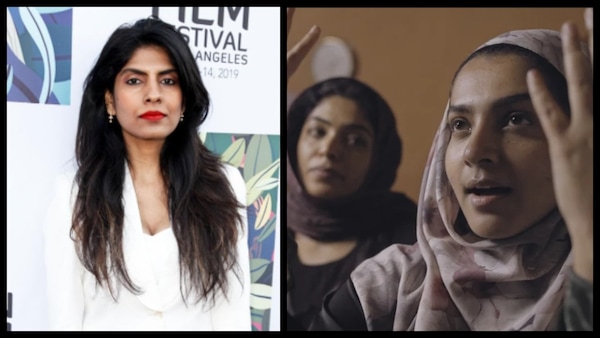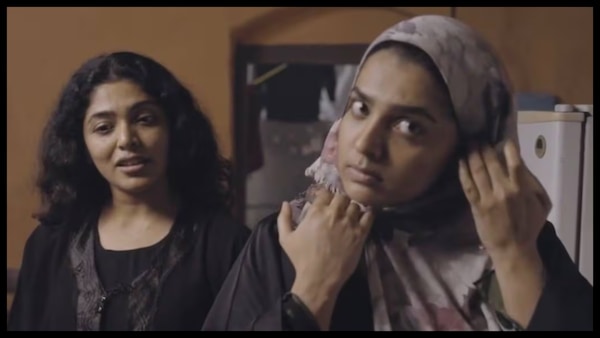Lalanna’s Song director Megha Ramaswamy on casting Parvathy Thiruvothu and Rima Kallingal: ‘I love their politics and the women they represent’
In an exclusive interview with OTTplay, Megha Ramaswamy talks about her latest project Lalanna’s Song, working with established actors such as Parvathy Thiruvothu and Rima Kallingal, and more.

Lalanna’s Song director Megha Ramaswamy
Last Updated: 08.57 AM, May 06, 2025
Megha Ramaswamy collaborated as a writer on Bejoy Nambiar’s Shaitan, marking her debut in the filmdom. She then went on to write and direct projects, including the Abhay Deol-starrer film, What Are The Odds. Her latest project, Lalanna’s Song, recently made its OTT premiere on MUBI. The short film features Parvathy Thiruvothu and Rima Kallingal, along with Nakshatra Indrajith in the titular role. In an exclusive interview with OTTplay, Megha Ramaswamy talks about her latest project, working with established actors such as Parvathy Thiruvothu and Rima Kallingal, the significance of short films for women filmmakers and how male journalists have critiqued the works of female filmmakers over the years.
One can interpret Lalanna’s Song in different ways. What is the idea or message that you wanted to convey through the tale of two young mothers (Shoby and Miriam) and their encounter with the 12-year-old Lalanna?
The concept was all about the psychological horror of being women in spaces that are both domestic and external, and the positions they play in the kind of caste they belong to, the spaces they take up and the interactions they have with each other and also reflecting on the kind of strata of society they represent and the internal politics of that which eventually cumulates the story into making them behave the way they do.
The same scene, when the women come out of the supermarket after being frisked, is shown twice - from the versions of Shoby and Miriam. Could you tell us more about that?
My cinematographer (Kuldeep Mamania) has a huge role to play in that because he wanted to shoot the POVs of both the women because as actors they were so brilliant that we actually felt we were losing out on something staggering when it came to them. But I think the most important part was how an incident can profile two women belonging to different strata of society differently. Shoby is probably an upper caste women, and Miriam comes from the Muslim community. When the entitled or the sort of privileged woman is completely shattered that someone has dared to accuse her of stealing, when she comes from a world of abundance, where she doesn't have to steal. Whereas Miriam is used to this profiling. So these are personal voices, and I think they are very important to show the interplay of two voices at that point in time, visually and philosophically as well.

Could you tell us about your casting choices? Were Parvathy, Rima Kallingal, and - Nakshthra your first choices for the roles? How was your experience collaborating with them?
Absolutely. First of all, this casting coup was arranged by Geethu Mohandas (Moothon director) for me. I was absolutely obsessed with Parvathy and Rima. I used to follow them on Instagram a long time ago, and I love their politics. I love the women they represent and I love what they stand for, and it can only take those kinds of women in reality to portray those characters of Miriam and Shoby. And again, they have to have that nuanced understanding of the politics of the film, which they latched on to immediately.
Nakshatra was the right age, 11 or 12 at that point in time. She is Poornima Indrajith's daughter. We got in touch with her through a beautiful accident of sorts. Again, Geethu was instrumental. I sent the script to her. I was working with Geethu on a project of hers. It somehow came around and the girls were absolutely lovely to work with. They are national treasures for a reason.

Apart from Geetu Mohandas as the executive producer, Guneet Monga is also associated with the project as a co-producer. How has it been collaborating with them?
Geethu helped me introduce these wonderful series of actors, and when we were running out of funds to complete the film, it was Guneet to whom I reached out, and she immediately stepped in. And that's the importance of women helping women make films as well.
English Vinglish, Nil Battey Sannata and the best women-centric films to binge-watch on OTTplay Premium
How different or difficult was it to direct the two children, especially Nakshthra, because she was not playing the usual cutesy or smart kids, often seen in commercial films?
There is nothing cute or a moment of cuteness in this film. It wasn’t (difficult). If you see my past work, I have been working with children consistently. Something visually, I enjoy doing. The children don’t come with that baggage of performance. They come genuinely because they are interested in being a part of a set and bringing an energy to their characters which is their own. No matter what you write on paper, the way they interpret it is so personal. So there is only so much through which you can direct a child, after that your job becomes about what you can derive directorially out of that child’s performance.
Nakshatra is so instinctive and intuitive, it is amazing that an 11-year-old child could interpret the character with so much depth and understanding. It has been a consistent feedback we have been getting. Of course, there are Parvathy and Rima, their performances are brilliant, but it is what Nakshatra does in bringing that intensity to that character which is equally upsetting and enduring in a way because she is a child at the end of the day. She is a victim of bullying by these two adult women who force her to sing. The way she was able to represent the politics of the film, both tenderly and madly, was a revelation for me. The way she got into her character - she became Lalanna, especially with that song and she sang that song. The way Sneha (who composed the music) was able to direct Nakshathra to sing Lalanna's song, and so much of that performance went into Nakshathra singing that song with so much anger. A feminist manifesto of sorts.
For a young woman to understand it, take up that space and perform it the way she has - it is really commendable. It is crazy how much an 11-year-old has taken up on her shoulder. It was also lovely that both Rima and Parvathy, established actors, made space for such a young, important child actor.
Lalanna’s Song had its festival run in 2022, but it is getting a digital home only in 2025?
It had a long festival run. It went to IFFLA (Indian Film Festival of Los Angeles), and it won there. It went to the Final Girls Berlin Film Festival and all these amazing genre festivals. It had a wonderful festival run in India too, where it went to Dharamshala (Dharamshala International Film Festival [DIFF]). It got selected for MAMI, but that year MAMI got cancelled, so we were not able to show it there. So I am so excited that after all these festivals, we are finally premiering in India on MUBI so we will have the right kind of audience also watching the film, who will question the politics of the film and also understand the nuances as well.
You have written and directed Lalanna's Song. But in your debut work, you are credited as the writer for Bejoy Nambiar’s Shaitan. You prefer to write and direct as you have more control over the material when you are the writer as well?
I will be very frank. The kind of material I write, only I can direct. And that's how I learned direction. I am not a trained director, I am a trained screenwriter. So direction came to me after my own experiments and understanding. Direction came to me much later. So after writing, I wanted to direct as well. Even now, I take up screenwriting for projects because there is a flow of income, hopefully.
Recently, All We Imagine as Light director Payal Kapadia said that she was asked by male journalists about making a film that has only females in it and about women’s friendship? She responded by asking, “You don’t ask Guy Ritchie why he made a movie with only men fighting for diamonds”. So the battles for women filmmakers go beyond just making films, women also come under scrutiny for the choices they make - the politics and casting. What is your take on that?
Women are punished a lot of times, especially for this genre. It is a punishment. If a male filmmaker experiments, the amount of celebration they get, whereas when a woman filmmaker experiments, they are punished by male reviewers, critics. It is crazy how much support male filmmakers have through male critics and male journalists. But male critics don't realise that we are not equal. Men and women in the world of filmmaking have not reached that equality. Till women make films, you have to welcome us. No matter how flawed our films are. Critique them correctly. Don't critique them in a personal manner. Critique them in a way that will encourage women to make films. Don't punish them for their choices. This is something I really feel strongly about. The bias is particularly in male journalists throughout the history of films in India. And these are also renowned journalists as well. Women actors, directors and performers as opposed to mediocre men doing far worse than their female counterparts. It is amazing the way men hold space for each other and get so rattled by women doing the same in their films. I find it very amusing.
You have also done the feature film - What Are The Odds. What is your preferred choice of filmmaking - short film or full-length feature film? Does the duration matter?

I love the short film format. Nobody talks about this enough. Short films are very important for women filmmakers. Economically, we can't afford making a feature film, and we have to show to our male counterparts to get us into the industry that we can also make films. So what do we do? We pull in favours, we save up our money, we make our first short film, so that we get noticed. So we have to understand that the economics of short film has supported women throughout history. It is also women filmmakers who consistently make short films. Secondly, there is no box office, and there is no censorship in the short film format. It is a friendly format. Also, when you don't have work in an industry, and feel creatively stunted, what do you do? Because it takes years to put together a feature, so in the meanwhile, you keep yourself busy, you keep yourself mentally alert, and make a short film. I think short films bring in a democracy that I have learned to respect over the years. And they are something I will constantly make, whether I am making features, or between features, I will also make short films.
About your upcoming projects
My next film is a children’s film, and it also has strong, beautiful women characters because my world is filled with women who are deliciously complicated, and straightforward as well. It is like a gamut of emotions that women have inspired me, and people who identify as women have inspired me to represent.
Subscribe to our newsletter for top content, delivered fast.

